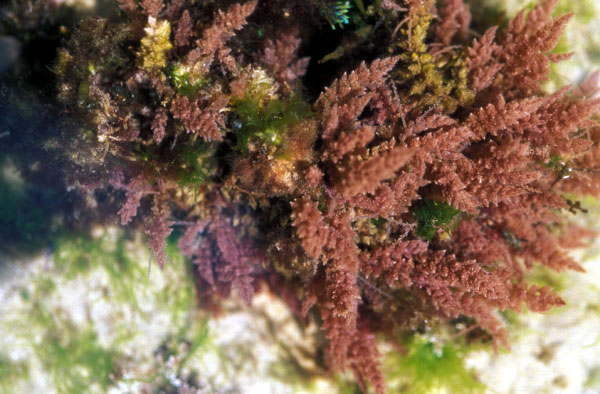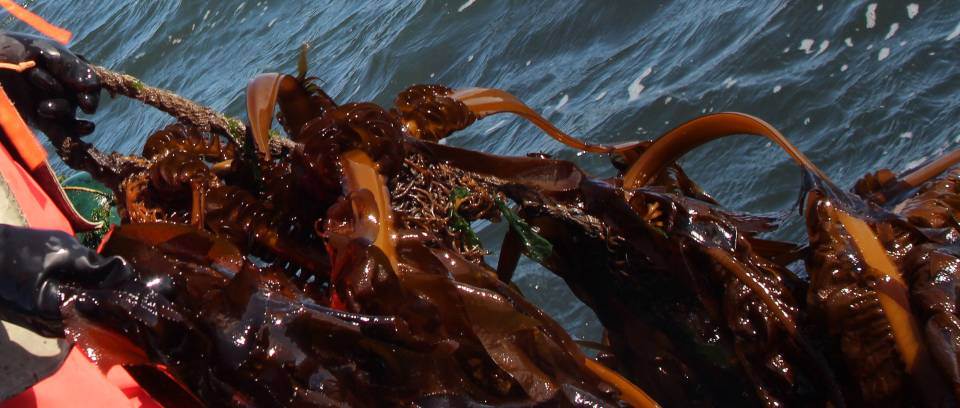Magnetic iron oxide nanoparticles (Fe3O4MNPs) are among the most useful metalnanoparticles for multiple applications across a broad spectrum in the biomedical field, includ-ing the diagnosis and treatment of cancer. In previous work, we synthesized and characterizedFe3O4MNPs using a simple, rapid, safe, efficient, one-step green method involving reduction offerric chloride solution using brown seaweed (Sargassum muticum) aqueous extract containinghydroxyl, carboxyl, and amino functional groups mainly relevant to polysaccharides, which actsas a potential stabilizer and metal reductant agent. The aim of this study was to evaluate the invitro cytotoxic activity and cellular effects of these Fe3O4MNPs. Their in vitro anticancer activitywas demonstrated in human cell lines for leukemia (Jurkat cells), breast cancer (MCF-7cells),cervical cancer (HeLa cells), and liver cancer (HepG2cells). The cancer cells were treated withdifferent concentrations of Fe3O4MNPs, and an MTT (3-[4,5-dimethylthiazol-2-yl]-2,5 diphenyltetrazolium bromide) assay was used to test for cytotoxicity, resulting in an inhibitory concentra-tion 50 (IC50)value of 23.83±1.1μg/mL (HepG2), 18.75±2.1μg/mL (MCF-7), 12.5±1.7μg/mL(HeLa), and 6.4±2.3μg/mL (Jurkat) 72hours after treatment. Therefore, Jurkat cells were selectedfor further investigation. The representative dot plots from flow cytometric analysis of apoptosisshowed that the percentages of cells in early apoptosis and late apoptosis were increased. Cellcycle analysis showed a significant increase in accumulation of Fe3O4MNP-treated cells atsub-G1phase, confirming induction of apoptosis by Fe3O4MNPs. The Fe3O4MNPs also activatedcaspase-3and caspase-9in a time-response fashion. The nature of the biosynthesis and thera-peutic potential of Fe3O4MNPs could pave the way for further research on the green synthesisof therapeutic agents, particularly in nanomedicine, to assist in the treatment of cancer.
Digital library
-
-
The present paper deals with the distribution of seaweeds and seagrasses during the deep sea survey conducted in the first sector from Kattapadu to Tiruchendur in Tamil Nadu coast between December 1986 and March 1987 covering an area of 650 sq.km. In this survey 58 species of marine algae were recorded of which 7 belong to Chlorophyta 12 to Phaeophyta and 39 to Rhodophyta. Three species of seagrasses viz. Cymodocea serrulata. Halophila ovails and H. ovala were also recorded at the depths ranging from 5.5 to 21.5 III Halim eda macroloba, Dictyota barlayresiana, D. Maxima, Gracliaria corticata var. corticala, G. edulis, Sarcodia indica, Sarconema filiform e, Soliena robusta, flypnea esperi and H. Valentiae were found to be dominant and widely distributed.
-
The two chief types of plants occurring in the marine environment are the algae and sea grasses. These are capable of synthesizing the complex organic substances from the simple inorganic compounds present in sea water. Sea grasses are the seed producing plants which fall into the botanical division of Spermatophyta, whereas marine algae are the primitive group of plants with no true roots, stems and leaves as observed in higher plants and these come under the division Thallophyta. This division also includes certain fungi and bacteria, the latter especially forming an important group in the organic productivity of the sea. Among the algae in the marine habitats, the microscopic and free floating or swimming forms are known as Phytoplankton.The other macroscopic or attached ones, which often grow in the intertidal and subtidal environments, are commonly referred to as Seaweeds.
Most of these marine algae or seaweeds are beautifully coloured and attached to rocks or grow on other plants as epiphytes. A few of them are buried inside the sand and sometimes occur as loose lying communities. Depending upon the type of pigment present in them and other morphological and anatomical characters, macroscopic algae are subdivided into the following four classes: 1.Green Algae (Chlorophyceae) 2. Brown Algae (Phaeophyceae) 3. Red Algae (Rhodophyceae) 4. Blue-green Algae (Myxophyceae) Algae belonging to the first three classes are treated here in detail since they constitute the vast majority of seaweeds of economic importance. Among the blue-green algae, some freshwater species of Nostoc are used as food gelly and many others are capable of fixing nitrogen and maintaining the fertility of the soil. Some information available on the marine flowering plants or sea grasses has also been included in this bulletin.
-
Seaweed industry is a promising and flourishing industry in India. About 700 species of seaweeds have been reported from east and west coasts of India and from Lakshadweep and Andaman-Nicobar. They belong to four groups namely green, brown, red and blue-green algae. At present the seaweeds exploited from natural seaweed beds are used for agar and sodium alginate only. They can also be used for the production of other phytochemicals such as agarose, carrageenan and also for fertilizer, human food and animal feed. Though many species of seaweeds viz. Gelidiella acerosa, Gracilaria edulis, Gracilaria crassa, Gracilaria verrucosa, Sargassum spp. and Turbinaria spp. are harvested from the natural seaweed beds, the fishermen involved in their collection are not fully aware of these species and also other economically important seaweeds growing in the vicinity.
-
The pretreatment of seaweed by washing in freshwater is often used in seaweed biofuel research studies. However, the effect of washing seaweed prior to anaerobic digestion (AD) does not appear to have been greatly studied. This study examines washing Sargassum muticum with freshwater and its effect on ultimate and proximate analyses, salt content, methane production from anaerobic digestion, and leachate loss from ensiling. Washing with freshwater significantly (p < 0.01) increased moisture content (unwashed 85.6%, washed 89.1%) but significantly (p < 0.05) reduced ash (unwashed 32.7% dry weight dw, washed 30.6% dw) and salt content (unwashed ash containing 51.5%, washed 42.5%). The dry biomass higher heating value was significantly (p < 0.05) increased by washing due to the lower ash content (11.5 to 12.6 kJ g−1 dw). There was no significant change in the protein or lipid content, although washing increased the nitrogen content (3.85–4.77% dw). Washing significantly (p < 0.05) increased leachate losses during ensiling, with total leachate losses increasing after washing (12.7–25.2%). The methane yield from anaerobic digestion (28 days) was not statistically significantly different (p > 0.05) between unwashed (0.225 L CH4 g−1 VS) and washed samples (0.177 L CH4 g-1 VS). However, washing delayed biomethane production.
-
Humic acids extracted from the sediment of Cochin inshore areas exhibited impairment of mercury toxicity to marine algae maintained in Walne's medium under laboratory conditions. Cultures of marine micro alga /50chrysis galbana contaminated with sublethal concentration of 10 ppb of inorganic mercury and 10 ppm humic acids registered 18%, 21 % and 37% increase in oxygen production for two, four and six hours incubation in light respectively, when compared to the controls. Similarly the daily growth rate of seaweed Ulva lactuca registered 26% increase over the control when the seaweed was maintained in medium containing 30 ppb Hg and 30 ppm humic acids.
-
Aquaculture has been the subject of two recent high profile reports. The first, entitled Blue Frontiers, begins by asserting ‘There is a pressing need to elevate the debate on the future of aquaculture and to place this in the context of other animal food production systems, including wild capture fisheries’. The second report made the front cover of Time Magazine and poses the question ‘Can farming save the last wild food?"
-
In the search for renewable fuels, there’s no perfect solution. Biofuels can be readily made from corn starch and sugar cane, but they take land and resources away from food crops. Feedstocks such as switchgrass and wood sidestep that problem—but they are hamstrung by a molecule called lignin, which makes it harder to extract the sugars that ferment into ethanol.
-
The present investigation indicates that G. edulis can be successfully cultivated on commercial scale in the nearshore areas of Gulf of Mannar during the five months period from November to March when the sea is calm. The shallow waters near CMFRI fish farm in Palk Bay are not suitable for G. edulis cultivation as the growth of the plant was affected by various environmental factors mentioned above. The culture experiments of G. edulis conducted earlier by the Central Marine Fisheries Research Institute in 3 - 4 m depth area at Palk Bay near CMFRI fish farm showed good growth of plants as there was less sedimentation, fouling organisms and predators. Hence G. edulis could be cultivated in deep waters in Palk Bay side and attempts may also be made to culture G. edulis in shallow waters at other areas of Palk Bay in order to select the suitable culture sites and period of good growth.
-
A PDF Power Point of "Evaluation of Biofuel Co-products as Ingredients for Aquafeeds".





